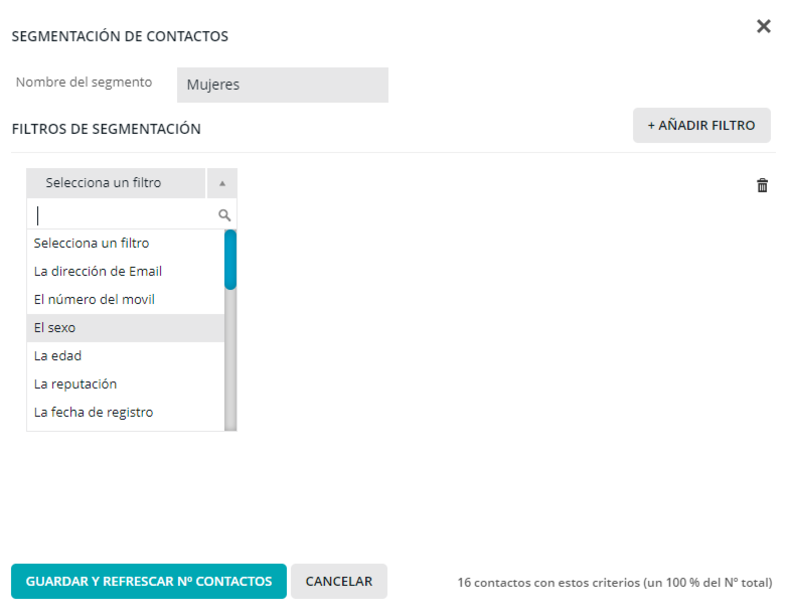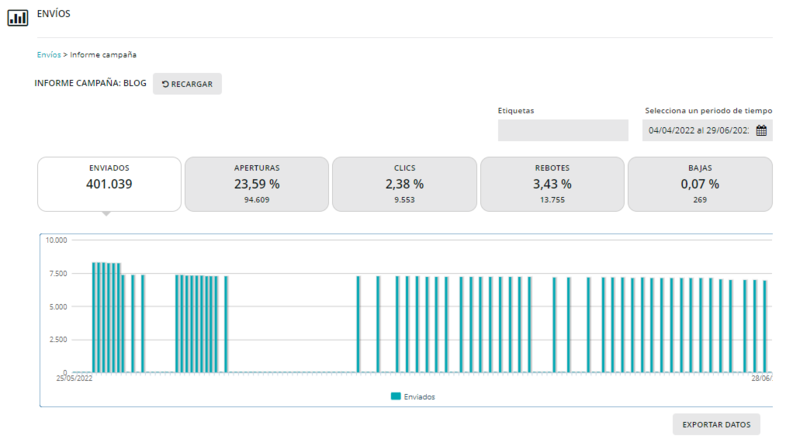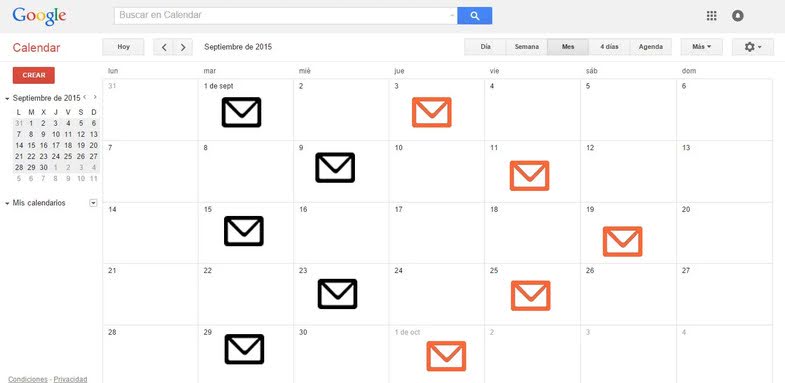Email Marketing and ROI: How to calculate It and tips to improve It
the 19 of March of 2024
the 19/03/2024

In the world of email marketing, ROI (Return on Investment) is a fundamental metric for evaluating the performance and effectiveness of email campaigns. This indicator measures the success of a strategy by comparing the benefits obtained with the economic investment made. In the context of email marketing, understanding and calculating the ROI is crucial to optimize resources and maximize results.
Despite the passage of time and the emergence of new communication methods, the ROI of email marketing remains at the top. According to Oberlo, every dollar invested generates an estimated average return of $42.
In this post, we will detail how to calculate ROI in email marketing, highlighting key factors to consider for accurate and meaningful evaluation.
TABLE OF CONTENTS
How to Calculate ROI in Email Marketing
To calculate the ROI of your email marketing campaigns, you need to apply a simple numerical formula:
ROI = (Revenue Generated – Investment Cost) / Investment Cost, then multiply by 100.
This involves comparing the revenue generated by an email marketing campaign with the costs associated with its execution.
To understand in detail how the ROI formula works, it’s best to see how the formula unfolds and what information can be interpreted from the result:
If your company earned 1,000 euros in profit from an email marketing campaign after investing 100 euros, the return on investment would be 9 euros per euro, or 900%. In formula format, it would look like this:
(1,000 euros profit – 100 euros investment / 100 euros investment) = 9 euros gain per euro invested in the campaign.
You can also calculate the ROI as a percentage. Simply take the result and multiply by 100:
9 x 100 = 900; 900% would be the ROI for this campaign.
Before doing this calculation, it’s important to set the overall objective of the campaign, as not all campaigns aim to generate sales. When there are no investments or conversions, the calculation becomes more complex.
MDirector ROI Calculator: Measure the Effectiveness of Your Campaigns Here
To facilitate the evaluation of your email marketing campaign’s effectiveness, MDirector has developed its own ROI calculator. This tool allows you to get a clear and quick view of the return on investment in your email campaigns, simplifying the process of measuring and analyzing results.
With MDirector’s ROI calculator, you’ll be able to make informed decisions and optimize your email marketing strategy to achieve the best possible results.
It’s important to understand the factors involved in this calculation:
- Number of Contacts: The size of your audience directly influences the campaign’s effectiveness. The larger the number of contacts, the greater the potential reach and conversion rate.
- Campaign Costs: This includes all the money invested from content creation to email sending. It covers design, copywriting, automation tools, and any other related expenses.
- Open Rate: This index reflects the percentage of recipients who open the email. A high open rate indicates good effectiveness in design and subject lines, increasing the chances of conversion.
- Conversion Rate: This determines what percentage of recipients take the desired action after opening the email. This factor is crucial for measuring the real effectiveness of the campaign.
- Earnings per Conversion: This represents the average value obtained from each desired action taken by the recipients. It’s important for evaluating the actual return on investment in email marketing.
Tips to Improve ROI in Email Marketing
To optimize this percentage, it’s advisable to follow these guidelines:
- Segment Your Audience: This action involves dividing your email list into smaller groups with similar characteristics, such as age, geographical location, purchase history, or interests. By targeting specific messages to each segment, you can increase the relevance and personalization of your campaigns, resulting in better rates in key email marketing metrics. Segmentation also allows you to send more relevant content, enhancing the user experience and strengthening relationships with your subscribers.
- Personalize Content: Use the information you have about your subscribers, such as their purchase history, browsing behavior, or product preferences, to tailor the content of your messages individually. Personalization increases the emotional connection with recipients and improves the likelihood of them taking the desired action.
- Optimize Subject Lines: They are the first impression your subscribers have of your email. It’s important to create persuasive and clear subject lines that capture the recipient’s attention. Experiment with different approaches, such as using questions, numbers, keywords, or urgency, and conduct A/B tests to determine which subject lines yield better results in terms of open rates.
- Improve Design and Usability: An attractive and easy-to-read design is essential to capture and retain your subscribers’ attention. Ensure that your emails are visually appealing, with a clean design, high-quality images, and a clear structure. Additionally, optimize usability by making sure your emails are easily readable on both mobile and desktop devices.
- Clear and Effective CTAs: It’s important that your call to actions are clear, specific, and convincing, using persuasive and direct language that encourages recipients to take the desired action. Additionally, make sure your CTAs are visually prominent and easily identifiable within the email.
- Offer Valuable Content: Provide useful and interesting material that addresses your subscribers’ needs, questions, or interests. This could include tips, tutorials, guides, case studies, industry news, or exclusive information.
- Create A/B Tests: A/B testing allows you to compare different versions of your emails to determine which elements generate better results in terms of opens, clicks, and conversions. Experiment with different variables, such as subject lines, content, design, images, or calls to action, and use the data gathered across your marketing channels (such as social media) to continuously optimize your campaigns and improve their effectiveness.
- Use Automation and Triggers: This allows you to send personalized messages at specific moments in the customer lifecycle, such as welcome messages, abandoned cart reminders, or post-purchase follow-up emails. Triggers are actions users take, such as subscribing to a list, visiting a webpage, or making a purchase, that automatically activate the sending of relevant emails.
- Analyze and Track: Constantly monitor the most important metrics of your email campaigns, such as open, click, and conversion rates. MDirector provides the necessary tools to collect and analyze data on your email performance. Use these insights to identify areas for improvement and make data-driven decisions about future marketing strategies and tactics.
- Optimize Sending Frequency: Find the right balance between maintaining relevance and not overwhelming your subscribers’ inboxes with too many emails. Adjust the sending frequency according to your audience’s preferences and behavior. Monitor engagement metrics closely and adjust your sending frequency as necessary to maximize ROI in email marketing.
- Manage Your Subscriber List: Regularly clean your list to remove invalid email addresses, inactive subscribers, or those who do not engage with your emails. MDirector helps you with this task by automatically managing both unsubscribes and bounces. Additionally, the contact reputation system simplifies the process of identifying inactive or non-engaged subscribers. This step is crucial to maintaining a clean and updated database, improving email deliverability, and maximizing the ROI of your campaigns.
- Offer Exclusive Promotions: Encourage participation and loyalty from your followers by offering exclusive promotions, discounts, or special offers. Exclusivity makes your emails more attractive and valuable, increasing the likelihood that recipients will open your messages and take the desired action.
- Request Feedback from Subscribers: Encourage subscriber engagement and feedback by asking for their opinions and suggestions. You can include surveys, feedback forms, or open-ended questions in your emails to gather information about customer satisfaction, content preferences, shopping experience, or other relevant aspects.
In summary, calculating ROI in an email marketing campaign is essential for evaluating its profitability. It’s crucial to understand whether your efforts are generating tangible revenue or if, on the contrary, you are wasting resources. This metric provides the clarity needed to make informed decisions and adjust your current strategy based on the results obtained, thereby maximizing the profitability of your email marketing actions.
The factors mentioned in this article, from audience segmentation to contact list management, directly impact this calculation, influencing the revenue generated and associated costs. Applying this knowledge will help you improve your email marketing strategies and, consequently, the performance of your investment in them.




















